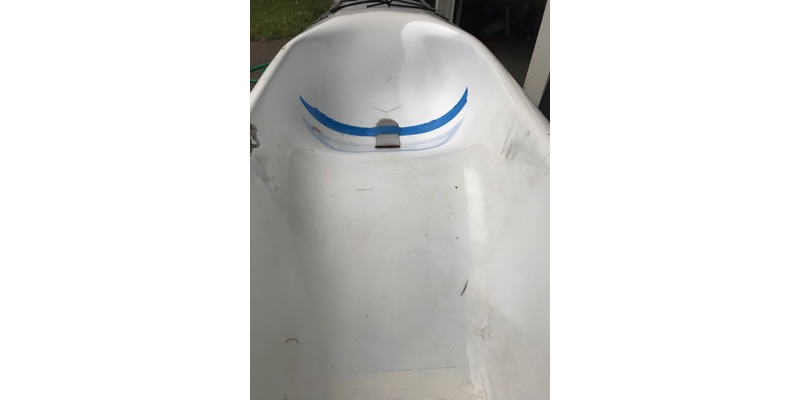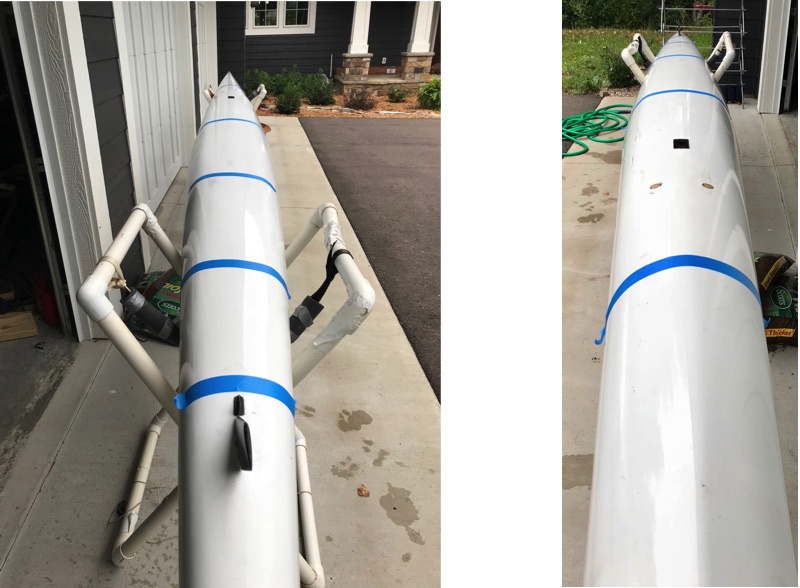
[Editor: Knysna Racing Kayaks released the Lee McGregor-designed Classic and Rhythm surfskis in 2017. Contributor and passionate surfski paddler Erik Borgnes has been paddling both them; here's what he thinks of these "short" boats...]
I'm now on my third "short" racing ski after a long string of standard length ocean skis. Right now, I have the McGregor Classic, released in early 2017, and the McGregor Rhythm, released shortly afterwards. I didn't think that I'd fit in the Classic when I read the early reports on the ski, so I bought a Rhythm.
Then, during a moment of insanity, I hopped an early morning flight from Wisconsin to Florida, rented a car and drove through 30 miles of flooding roads during a week-long South Florida rainstorm, met up with Bruce Gipson of Venturesports, demo’d the Classic, and flew back home that evening. That’s nuts, right? "Unfortunately", I fit in the Classic just fine and had no seat issues after our one hour paddle, so I ended up buying the Classic, too.
CLASSIC
First Looks
The Classic is 19’ 4 long x 16.1” wide (590 cm x 41 cm width) and listed as being for paddlers under 90 kg weight.
It looks like a K2 bow mated to a standard ski stern. The hull cross section is a narrow U at the bow, is flat under the seat, and progresses to a boxy curve at the stern. The "chines" under the seat area are about the width of your sit bones / ischial tuberosities, or just slightly wider.

The seat is deep and the bottom of the seat pan is flatter and wider than usual - so the seat shape sort of follows the inner contour of the hull underneath it. The seat bottom feels a bit higher than your heels, though, so the sitting position is pretty good and since I usually sit on a 1 cm thick seat pad, it’s pretty darn comfortable. The knee hump seems standard height as does the gunwale height. Rocker is pretty generous both in how it looks and in the way the ski behaves on the water.

The weight of this ski is about 22 lbs (10.5 kg), so it is very lightweight.
It feels adequately stiff in the hand and on the water. My ski had no soft spots or significant “oil canning” in the hull. I can’t really say much about the build quality other than to say that I have had no issues with this ski and it’s been completely watertight. The footrest flexed too much for my liking, and the footpedal surfaces didn't align perfectly with the footrest which bothered my big feet, so I swapped it out for a stiffer footrest and redrilled holes as was necessary to make it fit. Most paddlers probably wouldn't feel the need to do that - only the finicky ones like me.
The rudder crosspiece is like the one on Fenn skis and fine for what it does, but I wanted more security and the ability to use a variety of rudders, so I swapped the Classic's out for a Think crosspiece and Think rudder (both take the same size shaft. An Uno Max rudder with one or two thin washers works for shaft length). The ski came with scuppers, which I'd probably leave alone if I mainly paddled in the ocean, but for flatter water use, I blocked off the scuppers and had a bailer installed.
Comfort
The Classic is the skinniest ski that I can fit my rear end into. Because the hull is chined, the bottom of the seat is wide, and I drop all the way down to the bottom of the seat without hip pinch. The sides of the seat are vertical, meaning that they don't flare outwards at the top. The back of the seat bucket doesn't flare back like some newer skis do.
The boxy seat cross section feels about like the Gen1 and Gen2 Think Uno, though the Classic's seat is just a hair wider from top to bottom. It’s also wider than the Gen 3 Uno Max, a ski that is too narrow for me. Compared to the Epics and the Nelo 560, the Classic's seat is wider at the bottom and narrower at the top. Like always, some will fit comfortably while others won't.
The footwell is narrower than a 2G V10 but not as narrow as the 3G Uno/Uno Max/Ion, and the catch is quite narrow as well.

Paddling - Flat Water
On flat water, the Classic feels like it sinks down a bit, especially under my 190 lbs (86 kg) weight. The flatness under the seat gives it a trace of initial stability. Lean it over to the side, and since the chine is right underneath you, it doesn't firm up all that much. Lean it over further, ...and I can't because the opposite gunwale digs into my ribs and the ski won't lean any more.
Under power, the Classic feels halfway between an ICF K1 and a long ski in that it accelerates more easily both from low and high speeds than a long ski, but not as well as a K1. The corrollary to that, however, is that it also probably decelerates faster than a longer ski does. I would think that as long as the deceleration rate between strokes is not too fast, or your stroke rate too low, then it might be a good trade-off.
Paddling this back to back with my Vajda Infusion 2 ICF K1, the stability feels fairly similar, so in other words, it's a fairly tippy elite level ski. The only reason that I am comfortable in the Classic in mildly rough water is that I fit pretty snugly in it, the seat is low, and the trace of initial stability keeps it feeling fairly planted on the water - all of which keep me from panicking.
Paddling in Waves
In multidirectional waves of 1 ft (30 cm) or so, the Classic feels pretty solid for a short, skinny, lightweight ski, though it's still a handful due to the narrow beam, the flatter hull, and the high rocker. On small downwind runs, with waves up to 3 ft (1m), the Classic works well with the small volume skinny bow seeming to more easily punch through the waves ahead than longer higher volume skis with wider bows. I noticed this in the Nelo 560 as well.
Downwind in waves up to 3ft (1m), it really benefits from having a larger swept back rudder and a bow deflector. It’s easy to control on another ski’s wake and it picks up small runners well like most skis do. But, I find that I can get onto more runners in the Classic since it accelerates faster and with less effort.
Boat Speed?
I find it difficult to compare boat speed between elite level skis even when using my gps and HRM on flat and deep water because the differences between elite skis nowadays are so small.
An analogy I like to use is to compare elite skis like this to a single speed time trial bicycle with a gear size that correlates to our strength, fitness, paddle length, etc. A faster hull is like swapping out the wheels on that single speed bike for slightly more aero wheels - which should increase our speed, right? But it only sort of does. With the faster wheels, it takes less effort to bump up our speed during an interval, and we might be able to accelerate better, but in a longer effort, we tend to fall back to the same or nearly the same speed where our single gear feels most comfortable and efficient. This might just be a function of our own efficiency of muscle contraction - meaning that maybe we automatically settle in at our optimal cadence / stroke rate.
At any rate, I suspect the Classic is on par with other elite skis in terms of overall drag and how fast it is at marathon pace in the 7.5 to 8.5 mph (12 to 13.7 kph) range.

Seat first, Hull second
I like the design idea behind the Classic whether it was done on purpose or not: build a narrow racing ski but design the hull to accommodate the width of seat that will allow more paddlers to fit, i.e. design the hull around the seat. Sure, the hull would have been lower drag had it been optimized first but then the seat would have been really narrow or really high. The shorter length has less wetted surface area, so some of that extra form drag is made up.
Overall - Fun and Fast
Having used the McGregor Classic for a full year (minus 5 months of winter), I'm finding that it works very well for me as a flatter water ski because it meets the three main criteria which we all use: It's comfortable enough for how long I plan to be in it; it's fast enough so that I don't feel like I'm penalized for not being in a different ski; and it's fun to paddle. It's not a ski for everyone because it's a tippy elite level ski. It also wouldn't be my first choice in a bigger downwind, as a rough water ski, nor as an ocean ski (I mainly paddle large fresh water lakes and slow flowing rivers).
Several other very good paddlers have taken the Classic for a spin back to back with their standard longer elite ski or their K1, and they've all had the same impression in that the Classic feels surprisingly fast, comfortable, and fun to paddle. I suspect it accelerates well because the shorter length and narrow waterline gives them less wetted surface area, though maybe it's the rocker, or maybe it's the exaggerated swedeform shape, or maybe all three?